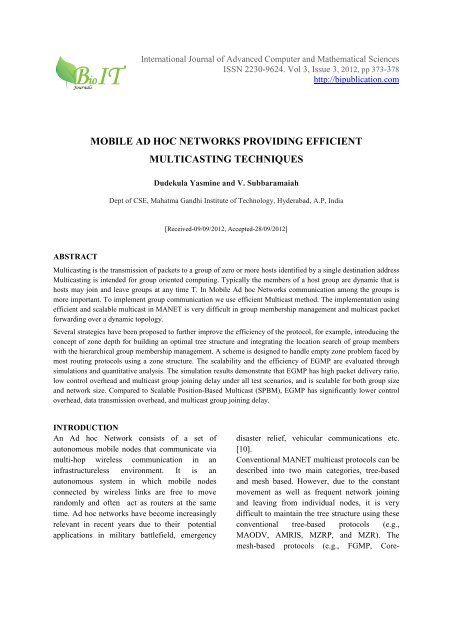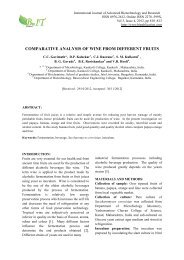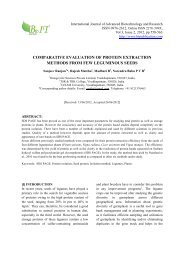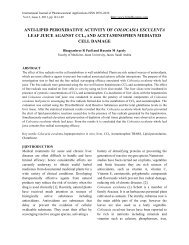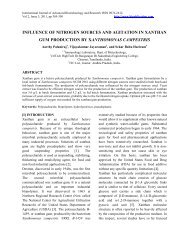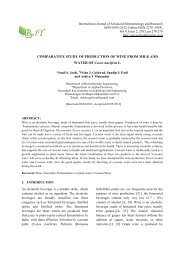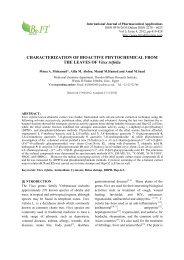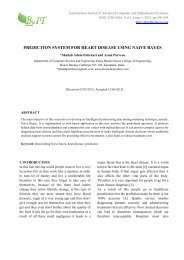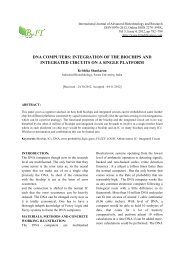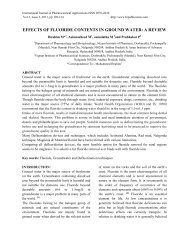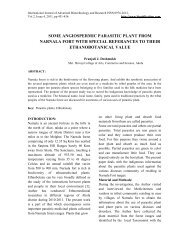mobile ad hoc networks providing efficient multicasting techniques
mobile ad hoc networks providing efficient multicasting techniques
mobile ad hoc networks providing efficient multicasting techniques
You also want an ePaper? Increase the reach of your titles
YUMPU automatically turns print PDFs into web optimized ePapers that Google loves.
International Journal of Advanced Computer and Mathematical SciencesISSN 2230-9624. Vol 3, Issue 3, 2012, pp 373-378http://bipublication.comMOBILE AD HOC NETWORKS PROVIDING EFFICIENTMULTICASTING TECHNIQUESDudekula Yasmine and V. SubbaramaiahDept of CSE, Mahatma Gandhi Institute of Technology, Hyderab<strong>ad</strong>, A.P, India[Received-09/09/2012, Accepted-28/09/2012]ABSTRACTMulticasting is the transmission of packets to a group of zero or more hosts identified by a single destination <strong>ad</strong>dressMulticasting is intended for group oriented computing. Typically the members of a host group are dynamic that ishosts may join and leave groups at any time T. In Mobile Ad <strong>hoc</strong> Networks communication among the groups ismore important. To implement group communication we use <strong>efficient</strong> Multicast method. The implementation using<strong>efficient</strong> and scalable multicast in MANET is very difficult in group membership management and multicast packetforwarding over a dynamic topology.Several strategies have been proposed to further improve the efficiency of the protocol, for example, introducing theconcept of zone depth for building an optimal tree structure and integrating the location search of group memberswith the hierarchical group membership management. A scheme is designed to handle empty zone problem faced bymost routing protocols using a zone structure. The scalability and the efficiency of EGMP are evaluated throughsimulations and quantitative analysis. The simulation results demonstrate that EGMP has high packet delivery ratio,low control overhe<strong>ad</strong> and multicast group joining delay under all test scenarios, and is scalable for both group sizeand network size. Compared to Scalable Position-Based Multicast (SPBM), EGMP has significantly lower controloverhe<strong>ad</strong>, data transmission overhe<strong>ad</strong>, and multicast group joining delay.INTRODUCTIONAn Ad <strong>hoc</strong> Network consists of a set ofautonomous <strong>mobile</strong> nodes that communicate viamulti-hop wireless communication in aninfrastructureless environment. It is anautonomous system in which <strong>mobile</strong> nodesconnected by wireless links are free to moverandomly and often act as routers at the sametime. Ad <strong>hoc</strong> <strong>networks</strong> have become increasinglyrelevant in recent years due to their potentialapplications in military battlefield, emergencydisaster relief, vehicular communications etc.[10].Conventional MANET multicast protocols can bedescribed into two main categories, tree-basedand mesh based. However, due to the constantmovement as well as frequent network joiningand leaving from individual nodes, it is verydifficult to maintain the tree structure using theseconventional tree-based protocols (e.g.,MAODV, AMRIS, MZRP, and MZR). Themesh-based protocols (e.g., FGMP, Core-
MOBILE AD HOC NETWORKS PROVIDING EFFICIENT MULTICASTING TECHNIQUESAssisted Mesh protocol, ODMR) are proposed toenhance the robustness with the use of redundantpaths between the source and the destination pairs[9].Conventional multicast protocols generally do nothave good scalability due to the overhe<strong>ad</strong>incurred for route searching, group membershipmanagement, and creation and maintenance ofthe tree/mesh structure over the dynamicMANET. For MANET uni-cast[4] routing,geographic routing protocols have been proposedin recent years for more scalable and robustpacket transmissions. The existing geographicrouting protocols generally assume <strong>mobile</strong> nodesare aware of their own positions through certainpositioning system, and a source can obtain thedestination position through some type[6] oflocation service an intermediate node makes itsforwarding decisions based[9]. on the destinationposition inserted in the packet he<strong>ad</strong>er by thesource and the positions of its one-hop neighborslearned from the periodic beaconing of theneighbors. By default, the packets are greedilyforwarded to the neighbor that allows for thegreatest geographic progress to the destination.When no such a neighbor exists, perimeterforwarding is used to recover from the local void,where a packet traverses the face of theplanarized local topology sub-graph by applyingthe right-hand rule until the greedy forwardingcan be resumed. Similarly[4], to reduce thetopology maintenance overhe<strong>ad</strong> and support morereliable <strong>multicasting</strong>, an option is to make use ofthe position information to guide multicastrouting. However, there are many challenges inimplementing an <strong>efficient</strong> and scalablegeographic multicast scheme in MANET[6].For example, in uni-cast geographic routing, thedestination position is carried in the packethe<strong>ad</strong>er to guide the packet forwarding, while inmulticast routing, the destination is a group ofmembers. A straight-forward way to extend thegeography-based transmission from uni-cast tomulticast is to put the <strong>ad</strong>dresses and positions ofall the members into the packet he<strong>ad</strong>er, however,the he<strong>ad</strong>er overhe<strong>ad</strong> will increase significantly asthe group size increases, which constrains theapplication of geographic <strong>multicasting</strong> only to asmall group. Besides requiring <strong>efficient</strong> packetforwarding[4], a scalable geographic multicastprotocol also needs to <strong>efficient</strong>ly manage themembership of a possibly large group, obtain thepositions of the members and build routing pathsto reach the members distributed in a possiblylarge network terrain. The existing small-groupbasedgeographic multicast protocols normally<strong>ad</strong>dress only part of these problems.ODMRP (On Demand Multicast RoutingProtocol) [6] is proposed to enhance therobustness with the use of redundant pathsbetween the source and the destination pair’sscalability due to the overhe<strong>ad</strong> incurred for routesearching, group membership management, andcreation and maintenance of the tree/meshstructure over the dynamic MANET.We introduce zone-supported geographicforwarding to reduce the routing failure, andprovide mechanism to handle zone partitioning.In <strong>ad</strong>dition, we introduce a path optimizationprocess to handle multiple paths, and provide <strong>ad</strong>etailed cost analysis to demonstrate thescalability of the proposed routing scheme [4].Techniques used for <strong>providing</strong> <strong>efficient</strong> andscalable multicast:1. Efficient Geographic Multicast ProtocolEGMP supports scalable and reliablemembership management and multicastforwarding through a two-tier virtual zone- basedstructure. At the lower layer, in reference to apre-determined virtual origin, the nodes in thenetwork self-organize themselves into a set ofzones as shown inDudekula Yasmine and V.Subbaramaiah 374
MOBILE AD HOC NETWORKS PROVIDING EFFICIENT MULTICASTING TECHNIQUES3. Multicast group joinFig. 1 and a le<strong>ad</strong>er is elected in a zone to managethe local group membership. At the upper layer,the le<strong>ad</strong>er serves as a representative for its zoneto join or leave a multicast group as required.As a result, a network-wide zone-based multicasttree is built. For <strong>efficient</strong> and reliablemanagement and transmissions, locationinformation will be integrated with the design andused to guide the zone construction, groupmembership management, multicast treeconstruction and maintenance, and packetforwarding.2. Multicast Tree ConstructionThe multicast tree creation and maintenanceschemes are provided. In EGMP, inste<strong>ad</strong> ofconnecting each group member directly to thetree, the tree is formed in the granularity of zonewith the guidance of location information, whichsignificantly reduces the tree managementoverhe<strong>ad</strong>. With a destination location, a controlmessage can be transmitted immediately withoutincurring a high overhe<strong>ad</strong> and delay to find thepath first, which enables quick group joining andleaving.When a node M wants to join the multicast groupG, if it is not a le<strong>ad</strong>er node, it sends a JOINREQ(M; PosM; G; fMoldg) message to its zLdr,carrying its <strong>ad</strong>dress, position, and group to join.The <strong>ad</strong>dress of the old group le<strong>ad</strong>er Mold is anoption used when there is a le<strong>ad</strong>er handoff and anew le<strong>ad</strong>er sends an updated JOIN REQ messageto its upstream zone. If M did not receive theNEW SESSION message or it just joined thenetwork.4. Packet sending from the sourceAfter the multicast tree is constructed, all thesources of the group could send packets to thetree and the packets will be forwarded along thetree. In most tree-based multicast protocols, <strong>ad</strong>ata source needs to send the packets initially tothe root of the tree. If this scheme is used andnode 5 in Fig. 1 is a source, node 5 needs to unicastthe packets initially to root zone (2, 2). Thesending of packets to the root would introduceextra delay especially when a source is far awayfrom the root. Inste<strong>ad</strong>, EGMP assumes a bidirectionaltree- based forwarding strategy, withwhich the multicast packets can flow not onlyfrom an upstream node/zone down to itsdownstream nodes/zones, but also from <strong>ad</strong>ownstream node/zone up to its upstreamnode/zone.Dudekula Yasmine and V.Subbaramaiah 375
MOBILE AD HOC NETWORKS PROVIDING EFFICIENT MULTICASTING TECHNIQUES5. Multicast data forwardingMaintain the multicast table, and the memberzones normally cannot be reached within one hopfrom the source. When a node N has a multicastPacket to forward to a list of destinations (D1;D2; D3; :), it decides the next hop node towardseach destination (for a zone, its center is used)using the geographic forwarding strategy. Afterdeciding the next hop nodes, N inserts the list ofnext hop nodes and the destinations associatedwith each next hop node in the packet [6] he<strong>ad</strong>er.An example list is (N1: D1; D3; N2: D2; :),where N1 is the next hop node for thedestinations D1 and D3, and N2 is the next hopnode for D2. Then N bro<strong>ad</strong>casts the packetpromiscuously (for reliability and efficiency).Upon receiving the packet, a neighbor node willkeep the packet if it is one of the next hop nodesor destinations, and drop the packet otherwise.When the node is associated with somedownstream destinations, it will continueforwarding packets similarly as done by nodeN[9]..6. Multicast Route Maintenance andOptimizationIn the zone structure, due to the movement ofnodes between different zones, some zones maybecome empty. It is critical to handle the emptyzone problem in a zone-based protocol.Compared to managing the connections ofindividual nodes, however, there is a much lowerrate of zone membership change and hence amuch lower overhe<strong>ad</strong> in maintaining the zonebasedtree[6].When a member node moves to a new zone, itmust rejoin the multicast tree through the newle<strong>ad</strong>er. When a le<strong>ad</strong>er is moving away from itscurrent zone, it must handover its multicast tableto the new le<strong>ad</strong>er in the zone, so that all thedownstream zones and nodes will remainconnected to the multicast tree.INPUT DESIGNThe input design is the link between theinformation system and the user. It comprises thedeveloping specification and procedures for datapreparation and those steps are necessary to puttransaction data in to a usable form for processingcan be achieved by inspecting the computer tore<strong>ad</strong> data from a written or printed document or itcan occur by having people keying the dat<strong>ad</strong>irectly into the system[6]. The design of inputfocuses on controlling the amount of inputrequired, controlling the errors, avoiding delay,avoiding extra steps and keeping the processsimple. The input is designed in such a way sothat it provides security and ease of use withretaining the privacy. Input Design considered thefollowing things: What data should be given as input? How the data should be arranged or coded? The dialog to guide the operating personnelin <strong>providing</strong> input. Methods for preparing input validations andsteps to follow when error occur.Dudekula Yasmine and V.Subbaramaiah 376
MOBILE AD HOC NETWORKS PROVIDING EFFICIENT MULTICASTING TECHNIQUESOBJECTIVES1. Input Design is the process of converting auser-oriented description of the input into acomputer-based system. This design is importantto avoid errors in the data input process and showthe correct direction to the management forgetting correct information from thecomputerized system.2. It is achieved by creating user-friendly screensfor the data entry to handle large volume of data.The goal of designing input is to make data entryeasier and to be free from errors. The data entryscreen is designed in such a way that all the datamanipulates can be performed. It also providesrecord viewing facilities [9].3. When the data is entered it will check for itsvalidity. Data can be entered with the help ofscreens. Appropriate messages are provided aswhen needed so that the user will not be in maizeof instant. Thus the objective of input design is tocreate an input layout that is easy to follow.OUTPUT DESIGNA quality output is one, which meets therequirements of the end user and presents theinformation clearly. In any system results ofprocessing are communicated to the users and toother system through outputs. In output design itis determined how the information is to bedisplaced for immediate need and also the hardcopy output. It is the most important and directsource information to the user. Efficient andintelligent output design improves the system’srelationship to help user decision-making.1. Designing computer output should proceed inan organized, well thought out manner; the rightoutput must be developed while ensuring thateach output element is designed so that peoplewill find the system can use easily andeffectively. When analysis design computeroutput, they should Identify the specific outputthat is needed to meet the requirements.2. Select methods for presenting information.3. Create document, report, or other formats thatcontain information produced by the system.The output form of an information system shouldaccomplish one or more of the followingobjectives. Convey information about past activities,current status or projections of the Future. Signal important events, opportunities,problems, or warnings. Trigger an action. Confirm an action.CONCLUSIONIn this paper, we proposed an <strong>efficient</strong> andscalable geographic multicast protocol, EGMP,for MANET. The scalability of EGMP isachieved through a two-tier virtual-zone-basedstructure, which takes <strong>ad</strong>vantage of the geometricinformation to greatly simplify the zonemanagement and packet forwarding. The positioninformation is used in the protocol to guide thezone structure building, multicast treeconstruction, maintenance, and multicast packetforwarding [6]. Compared to conventionaltopology based multicast protocols; the use oflocation information in EGMP significantlyreduces the tree construction and maintenanceoverhe<strong>ad</strong>, and enables quicker tree structure<strong>ad</strong>aptation to the network topology change. Wealso develop a scheme to handle the empty zoneproblem, which is challenging for the zone-basedprotocols. Additionally, EGMP makes use ofgeographic forwarding for reliable packettransmissions, and <strong>efficient</strong>ly tracks the positionsof multicast group members without resorting toan external location server [9].Dudekula Yasmine and V.Subbaramaiah 377
MOBILE AD HOC NETWORKS PROVIDING EFFICIENT MULTICASTING TECHNIQUESOur results indicate that geometric informationcan be used to more <strong>efficient</strong>ly construct andmaintain multicast structure, and to achieve morescalable and reliable multicast transmissions inthe presence of constant topology change ofMANET [9].Science and Telecommunications [Volume 3, Issue 6,June 2012]REFERENCE:[1] H. Kopka and P.W. Daly, A Guide to LATEX,third ed. Harlow, U.K.: Addison-Wesley, 1999.[2] L. Ji and M. S. Corson. Differential destinationmulticast: a MANET multicast routing protocol forsmall groups. In Proc. IEEE Infocom01, Anchorage,Alaska, April 2001.[3] E. M. Royer and C. E. Perkins. Multicast operationof the <strong>ad</strong> <strong>hoc</strong> on-demand distance vector routingprotocol in Proceedings of the ACM/IEEEInternational Conference on Mobile Computing andNetworking (MOBICOM), August 1999, pp. 207218.[4] C. Wu, Y. Tay, and C.-K. Toh. Ad <strong>hoc</strong> multicastrouting protocol utilizing increasing id-numbers(AMRIS) functional specification. Internet draft,November 1998.[5] X. Zhang and L. Jacob. Multicast zone routingprotocol in <strong>mobile</strong> <strong>ad</strong> <strong>hoc</strong> wireless <strong>networks</strong>. inProceedings of Local Computer Networks, 2003 (LCN03), October 2003.[6] C.-C. Chiang, M. Gerla, and L. Zhang. Forwardinggroup multicast protocol (FGMP) for multihop <strong>mobile</strong>wireless <strong>networks</strong> In AJ. Cluster Comp, Special Issueon Mobile Computing, vol. 1, no. 2, pp. 187196, 1998.[7] J. J. Garcia-Luna-Aceves and E. M<strong>ad</strong>ruga. Thecore-assisted mesh protocol. In IEEE JSAC, pp.13801394, August 1999.[8] M. Gerla, S. J. Lee, and W. Su. On-demandmulticast routing protocol (ODMRP) for <strong>ad</strong> <strong>hoc</strong><strong>networks</strong>. in Internet draft, draft-ietf-manet-odmrp-02.txt, 2000.[9] X.Xiang, X.Wang, and Y. Yang, “SupportingEfficient and Scalable Multicasting over Mobile AdHoc Networks”, IEEE Transactions on MobileComputing, Vol. 10, No.4, April 2011.[10] Sejal Butani, Shivani Desai and Shar<strong>ad</strong>a Valiveti,Providing Efficient Security in Multicast Routing forAd-<strong>hoc</strong> Networks, International Journal of ComputerDudekula Yasmine and V.Subbaramaiah 378


